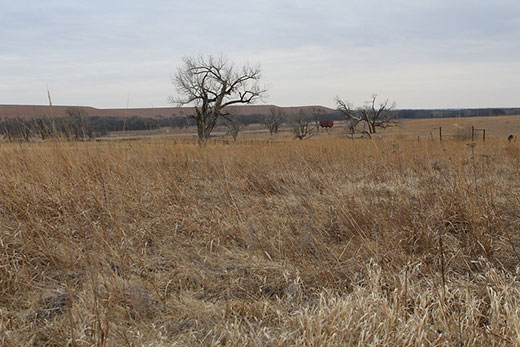
Woody encroachments, including some trees, can affect the health of native grassland. | Download this photo.
K-State researchers embark on study to preserve prairie health
$843K grant takes aim at woody encroachments on native grasslands
Jan. 31, 2023
By Pat Melgares, K-State Research and Extension news service
MANHATTAN, Kan. – Kansas State University researchers have launched a study to improve the effectiveness of controls on woody plants, an effort they say will help to preserve the health of native grasslands in Kansas.
Carol Baldwin, a range specialist in K-State’s Agriculture, Natural Resources and Community Vitality unit, said woody plants – a term that indicates plants with hard, wood stems – are encroaching on the Kansas prairie, creating a threat to wildlife habitat and livestock production. In the event of a prairie fire, woody plants add to the intensity of the blaze.
“The scale of the problem is large and is growing at an ever-increasing pace,” Baldwin said. “Individual landowners have made efforts to reduce woody plants but these have been insufficient to reverse the overall trend toward the increased conversion of native grass to undesirable woodlands.”
In 2022, the Natural Resources and Conservation Service awarded a three-year grant for $843,000 to a K-State team led by Baldwin to address the issue. The team includes K-State range management specialist Keith Harmoney, agricultural economist Gabe Sampson and wildlife specialist Drew Ricketts.
The researchers will focus their work on three grassland regions in Kansas: the Flint Hills (eastern Kansas), the Gypsum Hills (central) and the Smoky Hills (north-central).
“Old-growth Great Plains rangelands were developed with frequent fire,” Baldwin said. “Fire kept woody brush and trees from dominating the landscape and led to the development of the grass-dominated prairie biome, with its unique collection of plants, animals and ecosystem services.”
As an example, the Flint Hills are home to more than 150 bird, 40 reptile and amphibian and 35 mammal species. It provides grazing land for bison and cattle. And, numerous opportunities for hiking and other recreational activities exist throughout the nearly 10,000 square mile region.
The prairie’s diversity, though, is under threat by an increase in woody plants, according to Baldwin.
“To assist in reversing the trend of woodland expansion, this project will provide outreach education, fill key knowledge gaps and provide the NRCS with an evaluation of proven and novel approaches,” Baldwin said.
Among the outcomes, Baldwin said the researchers hope to encourage broader use of soil health practices, improve habitat for wildlife and improve forage and grazing distribution on rangelands.
Because native grassland is used for recreational activities, Baldwin said the projects will also aim to reach non-agriculture and recreationist landowners with information on managing rangeland.
“Woody plant control is just one part of maintaining biome-scale integrity, and other management practices can enhance or decrease the benefits,” Baldwin said. “We hope that promoting the efforts of landowners who have removed woody species will inspire others to act, as well.”
The project is expected to last through Sept. 2025.

